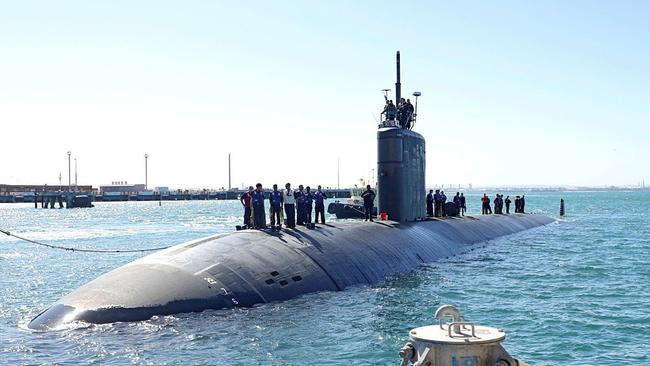AUKUS subs will help Australia keep Pacific enemies at bay

Coercion has become a daily feature of regional statecraft. Post-war norms are being flouted. The rules-based order is under growing pressure. In the West Philippine Sea, China’s vessels are using water cannon and unsafe manoeuvres against Philippine vessels and crew. This is occurring in the context of the largest military build-up the world has seen since World War II.
The Defence Strategic Review clearly identified the main author of that build-up. China spends more on defence than the next 25 regional countries, having raised spending by 75 per cent over the past decade compared to an average of 33 per cent. Its rise as a military power has been meteoric but without any reassurance on its strategic intent. Nothing better illustrates this than the transformation of the People’s Liberation Army Navy.
As China’s GDP soared from $US397bn in 1990 to almost $US15 trillion in 2020 – more than 11 Australian economies – the Chinese navy leapfrogged America’s.
Now armed with 370 warships, China’s navy is expected to grow to 440 ships by 2030, compared to the US’s 294 warships. As of 2022, Beijing took a 57-ship lead on the US. China has launched 75 new warships since 2018 and America 35. It is now the largest shipbuilder on Earth. Every four years, the Chinese navy adds 130 ships – more than three Royal Australian Navies – to its order of battle.
The Australian Defence Force is becoming smaller as a share of a regional balance of power that grows more lopsided each year. This is more than an American problem. It’s an Australian problem. We Australians aren’t free riders, we pay our fair share of defence spending. We are committed to the Indo-Pacific being a region where no one country dominates and where the sovereignty of all countries, large and small, is respected.
Enter AUKUS. For all the column inches it consumes, the AUKUS partnership between Australia, the United Kingdom and the United States is widely misunderstood. The optimal pathway – under which Australia will receive between three and five Virginia-class nuclear-powered submarines (SSNs) in the 2030s and build more SSNs in the 2040s – is rightly praised as an industrial boon that will generate 20,000 jobs. But, while this is certainly a reason to be excited about AUKUS, jobs are a by-product of its essential purpose.
The main reason to acquire SSNs is their potent strategic effect. They are overwhelmingly in Australia’s interest because they strengthen our ability to deter war by threatening painful consequences for aggression against Australia and its partners. In scenarios short of war, they will help us to sustain strategic equilibrium.

AUKUS submarines will make Australians safer by deterring multiple threats. In the defence of Australia, nuclear-powered submarines would cultivate uncertainty in an enemy’s war cabinet because they could be anywhere. Faced with a potentially devastating attack on their prized assets, all but the most adventurous attacker might be given pause for thought. This is what AUKUS is all about.
A strong and integrated submarine force will also ensure that we can resist efforts to cut us off from our allies in wartime if, for example, enemy submarines attempted to stop the US from fending off an attack on Australia.
If an enemy attempted to coerce us by blockading our ports – a scenario that has haunted generations of defence planners – our SSNs would sink the warships and submarines imposing the blockade. Similarly, they could deploy either Tomahawk missile strikes or infiltrate special forces to raid an enemy base if Australians woke to find a hostile power threatening to isolate Australia strategically, which has not happened since Japan ruled most of the region.
Nuclear-powered submarines will also enable Australia to help an Indo-Pacific partner in need. They can undertake freedom-of-navigation patrols across the region to keep open the arteries of global trade and support the law of the sea, which is central to the rules-based order Australia and the region rely on to shape a neighbourhood that is free, open and inclusive.
Just as the mechanical crossbow surpassed the slingshot, so a nuclear-powered submarine can reach further and strike harder than a conventional boat. These submarines will undertake the missions our Collins-class submarines conduct now but more efficiently and effectively by virtue of their greater stealth, speed, time on station, and ability to deter – and strike – targets at ranges of thousands of kilometres.
The cost of AUKUS reflects the value we should place on our way of life as a free people under the Southern Cross eager to protect ourselves from the threats materialising around us.
Luke Gosling is the Labor member for Solomon.





As Australians look north to Asia, the bitter truth is that they see a region heading in the wrong direction.